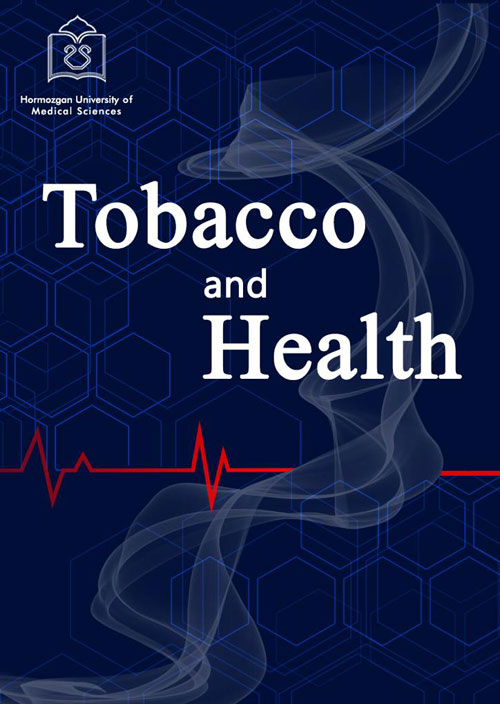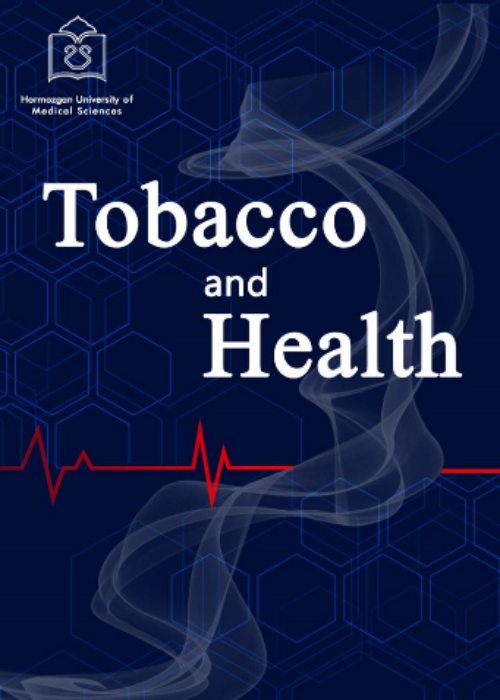فهرست مطالب

Tobacco and Health
Volume:1 Issue: 2, Apr 2022
- تاریخ انتشار: 1401/05/13
- تعداد عناوین: 8
-
Pages 58-62Background
Social media can be powerful tools to influence high-risk behaviors. This study aimed to evaluate tobacco-related images on Instagram’s Persian-language pages and their audience attraction rates.
Materials and MethodsThis cross-sectional study included 1870 Instagram posts with cigar, cigarette, e-cigarette, tobacco, vape, and shisha/waterpipe/hookah hashtags. The number of likes and comments for these posts were recorded, and the image type, the attitude of the audience, and the type of caption were noted as well.
ResultsIn general, 500 images (26.7%) had #cigar/cigarette, while 30 (1.6%), 470 (25.1%), 650 (34.8%), 70 (3.7%), and 150 (8%) images had #e-cigarette, #shisha/#waterpipe/#hookah, # tobacco, #juice, and #vape hashtags, respectively. The most common type of image was product images (52.4%). The audience’s attitude towards the images was mostly positive (93.2%). In addition, the most common caption type was sales (76.5%). There was a significant correlation between the number of likes and comments with image hashtags, audience attitude, and caption type. The highest number of likes and comments belonged to images with shisha/waterpipe/hookah hashtags and a positive audience attitude. The sales caption type had the highest number of likes, while the encouragement caption type had the highest number of comments. Eventually, text image types had the highest number of comments.
ConclusionGiven the high promotion of tobacco-related posts on Instagram, policymakers should take the necessary measures to reduce the volume of tobacco advertisements.
Keywords: Instagram, Tobacco, Smoking, Cigarette, Hookah -
Pages 63-67Background
Tobacco has been reported to have multiple negative effects on oral health. This study aimed to investigate the frequency of posterior teeth decay due to smokeless tobacco (ST).
Materials and MethodsThis cross-sectional study included consistent nas and tanbak users for more than 2 years in Bandar Abbas, Iran in 2018-2019. General characteristics, including age, gender, education, occupation, income, residence, the number of family members, and smoking status, as well as the duration of ST use, the use of mouth wash, and the frequency of using dental floss and toothbrush, were recorded based on the study aim. All patients underwent complete oral examination and posterior teeth decay was noted based on the results. The surface of teeth with decay (lingual, buccal, mesial, distal, and occlusal) was recorded as well.
ResultsFrom 150 patients evaluated in this study with a mean age of 37.95±12.02 years, 136 (90.7%) cases were males. Posterior teeth decay was found in 135 patients (90%). The mean number of decayed posterior teeth was 3.37±2.58. The highest decayed tooth surface was the mesial surface (78.7%), followed by the occlusal (77.3%) and the distal (76.7%) surfaces. The binary logistic regression model revealed that the odds of posterior teeth decay were approximately 4-folds higher in employed participants compared to the unemployed ones (OR=4.29, 95% CI: 1.19-15.49, P=0.026). Overall, occupation, income, duration of ST use, number of family members, and dental floss use were able to predict posterior teeth decay with an area under the ROC curve of 0.787 (95% CI: 0.671-0.902, P<0.001), the sensitivity of 85.9%, and specificity of 60%.
ConclusionA very high frequency of posterior teeth decay was observed in patients with≥2 years of ST use. Posterior teeth decay appears to be affected by a combination of factors such as occupation, income, duration of ST use, number of family members, and the use of dental floss.
Keywords: Smokeless tobacco, Tooth decay, Dental caries, Posterior teeth -
Pages 68-73Background
Hookah use has become highly popular among Iranian women. The objective of the present study was to identify the psychosocial factors affecting hookah use by women during 2018- 2019 using a conventional content analysis approach.
Materials and MethodsParticipants were invited to participate in a semi-structured interview by the purposeful method with maximum diversity in terms of age, education, occupation, hookah use status, and geographical areas of the city. Data were collected through in-depth individual interviews and analyzed through content analysis. The interview continued until obtaining no new category. Software MAXQDA (version 10) was used for data analysis.
ResultsIn general, 36 participants were interviewed based on the study aim. In this study, the focus was on the category of psychosocial needs, including 9 subcategories of searching for peace of mind, inner gap, physical and psychological dependence, need for recreation, curiosity, tendency to express oneself, attraction, satisfaction, companionship and competition with others, leisure time, pleasure, and inexperience.
ConclusionSeveral psychosocial factors were effective in hookah use among women. Providing the necessary recreational facilities for women and families and training life skills can be effective in reducing hookah use.
Keywords: Hookah, Qualitative research, Smoking, Tobacco, Water-pipe, Woman -
Pages 74-82Background
Smoking is increasing among adolescents and young adults. Adolescents’ smoking can predict frequent smoking in early adulthood. This study aimed to explore the predictors of smoking among high school students using health belief model (HBM).
Materials and MethodsIn this cross-sectional study conducted in 2019 in Bandar-Abbas city, South of Iran, 444 male high-school students aged 15-19 years (mean age: 16.7±0.85) were explored. Data were collected using a researcher-made questionnaire consisted of two main sections: sociodemographic characteristics and HBM constructs. The zero-inflated ordered probit (ZIOP) model was adopted for investigating the association between HBM constructs and smoking behavior.
ResultsResults indicated that 82% of the participants never smoked cigarette. The results of ZIOP model showed that the knowledge (P=0.026), susceptibility (P<0.001), severity (P=0.035), benefits (P=0.004), and cues to action (P=0.019) had significant effects on smoking cigarette after being adjusted for other covariates (i.e., age, parents’ education, losing one of the parents). Moreover, having a smoker friend was found to be an inflation factor (P<0.001). Adolescents with smoking friends were 44% less likely to avoid smoking.
ConclusionIt was concluded that having a smoker friend, knowledge, susceptibility, severity, benefits, and cues to action had considerable predictive capacity for predicting smoking attitude. Therefore, it was recommended that these factors should be seriously considered when designing educational programs with the aim of reducing adolescent smoking.
Keywords: Adolescents, Health belief model, Smoking, Students, ZIOP model -
Pages 83-93
Waterpipe use has grown significantly in recent years. Hookah use has been shown to be associated with various human health problems such as cardiovascular disease, respiratory disease, and cancer. The aim of this review study was to investigate the pollutants in the indoor air of waterpipe cafes. An automated literature search was conducted to identify any relevant studies published up to February 2022. For this search, international digital databases (PubMed, ScienceDirect, and Scopus) were chosen. Multiple keywords were used in the systematic literature review, including "hookah" OR "waterpipe" OR "hubble-bubble" OR "narghile" OR "shisha" AND "café" AND "indoor air." After removing duplicate papers and analyzing titles, abstracts, and full texts, 25 studies remained for analysis and interpretation. Particulate matter, polycyclic aromatic hydrocarbons (PAH), BTEX compounds, carbon monoxide (CO), nicotine, aldehydes, and bioaerosols were found to be the most prevalent and challenging contaminants in the indoor air of waterpipe cafes. Because of the growing popularity of waterpipe use in cafes, particularly among young people and teenagers, and the high concentration of pollutants in this area, as well as the long-term presence of individuals in these areas, it is necessary for officials to adopt restrictive laws in these places.
Keywords: Waterpipe café, Environmental pollutants, Indoor air -
Pages 94-99
Cigarette smoke and nicotine interact with drugs by affecting the absorption, distribution, metabolism, or elimination of other drugs, causing a change in drug response. Therefore, smokers usually need higher doses of medications. Articles were searched through advanced search in ScienceDirect, PubMed, Google Scholar, and SciELO databases. Finally, 28 articles were used in this study. We found that drugs may interact with each other when taking multiple medications, but these interactions are not always related to medications. Sometimes these interactions result from drugs reacting with food, beverages, and tobacco. Smokers have to take more doses of the drug for treatment in the long run, which can cause more side effects. In the long run, the person’s body becomes resistant to the drug and the dose has to be increased. Overuse of the drug causes the person to suffer more emotional and physical symptoms. Cigarettes can also have pharmacokinetic effects on some drugs (clozapine, olanzapine, and haloperidol). Tobacco causes nausea and the drug does not work well enough. In severe cases, the drug has to be injected intravenously, which makes the treatment much more difficult. Therefore, according to the studies, the patient’s history of smoking and alcohol consumption should be studied and medications should be prescribed according to it in order to treat in the best way.
Keywords: Tobacco, Drug interaction, Smoking -
Pages 100-106
Smoking is a well-known major risk factor for respiratory tract and other systemic infections. The World Health Organization estimates that between 2000 and 2025, about 9% of deaths will be caused by tobacco use, and more than half of all smokers die from smoking-related diseases. Smoking can damage almost all organs of the human body and is a major risk factor for respiratory infections and other infectious diseases. Smoking can increase the risk of respiratory infections through various mechanisms, which include changes in the structural, functional, and immune defenses of the host. Smoking is one of the most serious public health problems in the world. Promoting smoking cessation is the most practical and economical preventive measure to reduce the severity of tobacco-related infections. In this study, we investigated the role of smoking in increasing the risk of bacterial, fungal, viral, and parasitic infections. We also evaluated various mechanisms by which smoking increases the risk of tobacco-related infections.
Keywords: Smoking, Infection, COPD, CAP, Respiratory tract -
Pages 107-108


